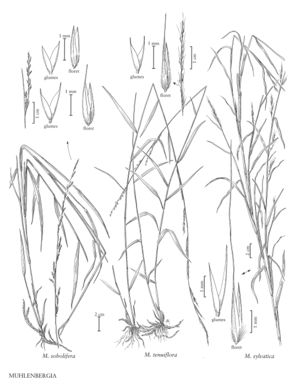Difference between revisions of "Muhlenbergia sylvatica"
FNA>Volume Importer |
imported>Volume Importer |
||
| (4 intermediate revisions by 2 users not shown) | |||
| Line 4: | Line 4: | ||
|publications= | |publications= | ||
|common_names=Woodland muhly;Muhlenbergie des bois | |common_names=Woodland muhly;Muhlenbergie des bois | ||
| + | |special_status={{Treatment/ID/Special_status | ||
| + | |code=E | ||
| + | |label=Endemic | ||
| + | }} | ||
|basionyms= | |basionyms= | ||
|synonyms={{Treatment/ID/Synonym | |synonyms={{Treatment/ID/Synonym | ||
|name=Muhlenbergia sylvatica var. robusta | |name=Muhlenbergia sylvatica var. robusta | ||
| − | |authority= | + | |authority= |
| + | |rank=variety | ||
}} {{Treatment/ID/Synonym | }} {{Treatment/ID/Synonym | ||
|name=Attenuata | |name=Attenuata | ||
| − | |authority= | + | |authority= |
| + | |rank=forma | ||
}} | }} | ||
|hierarchy=Poaceae;Poaceae subfam. Chloridoideae;Poaceae tribe Cynodonteae;Muhlenbergia;Muhlenbergia sylvatica | |hierarchy=Poaceae;Poaceae subfam. Chloridoideae;Poaceae tribe Cynodonteae;Muhlenbergia;Muhlenbergia sylvatica | ||
| Line 22: | Line 28: | ||
-->{{Treatment/Body | -->{{Treatment/Body | ||
| − | |distribution=Conn.;N.J.;N.Y.;W.Va.;Del.;D.C;Wis.;Ont.;Que.;N.H.;Tex.;N.C.;Tenn.;Pa.;Kans.;Nebr.;Okla.;S.Dak.;R.I.;Va.;Mass.;Maine;Vt.;Ala.;Ark.;Ill.;Ga.;Ind.;Iowa;Ariz.;Md.;Ohio;Mo.;Minn.;Mich.;Miss.;S.C.;Ky. | + | |distribution=Conn.;N.J.;N.Y.;W.Va.;Del.;D.C.;Wis.;Ont.;Que.;N.H.;Tex.;N.C.;Tenn.;Pa.;Kans.;Nebr.;Okla.;S.Dak.;R.I.;Va.;Mass.;Maine;Vt.;Ala.;Ark.;Ill.;Ga.;Ind.;Iowa;Ariz.;Md.;Ohio;Mo.;Minn.;Mich.;Miss.;S.C.;Ky. |
| − | |discussion=<p>Muhlenbergia sylvatica grows in upland forests, along creeks and hollows, on rocky ledges derived from sandstone, shale, or calcareous parent materials, moist prairies, and swamps, at elevations from 30-1500 m. It is restricted to the Flora region, its primary range being southeastern Canada and the midwestern and eastern United States. Reports from British Columbia were based on a misidentification (Douglas et al. 2002). The record from Arizona is based on the report in Kearney and Peebles (1951) of a collection made by Toumey at Grapevine Creek in the Grand Canyon.</p> | + | |discussion=<p><i>Muhlenbergia sylvatica</i> grows in upland forests, along creeks and hollows, on rocky ledges derived from sandstone, shale, or calcareous parent materials, moist prairies, and swamps, at elevations from 30-1500 m. It is restricted to the Flora region, its primary range being southeastern Canada and the midwestern and eastern United States. Reports from British Columbia were based on a misidentification (Douglas et al. 2002). The record from Arizona is based on the report in Kearney and Peebles (1951) of a collection made by Toumey at Grapevine Creek in the Grand Canyon.</p> |
|tables= | |tables= | ||
|references= | |references= | ||
| Line 32: | Line 38: | ||
-->{{#Taxon: | -->{{#Taxon: | ||
name=Muhlenbergia sylvatica | name=Muhlenbergia sylvatica | ||
| − | |||
|authority=(Torn) Torr. ex A. Gray | |authority=(Torn) Torr. ex A. Gray | ||
|rank=species | |rank=species | ||
| Line 39: | Line 44: | ||
|basionyms= | |basionyms= | ||
|family=Poaceae | |family=Poaceae | ||
| − | |illustrator=Linda A. Vorobik | + | |illustrator=Linda A. Vorobik;Annaliese Miller |
| − | |distribution=Conn.;N.J.;N.Y.;W.Va.;Del.;D.C;Wis.;Ont.;Que.;N.H.;Tex.;N.C.;Tenn.;Pa.;Kans.;Nebr.;Okla.;S.Dak.;R.I.;Va.;Mass.;Maine;Vt.;Ala.;Ark.;Ill.;Ga.;Ind.;Iowa;Ariz.;Md.;Ohio;Mo.;Minn.;Mich.;Miss.;S.C.;Ky. | + | |illustration copyright=Utah State University |
| + | |distribution=Conn.;N.J.;N.Y.;W.Va.;Del.;D.C.;Wis.;Ont.;Que.;N.H.;Tex.;N.C.;Tenn.;Pa.;Kans.;Nebr.;Okla.;S.Dak.;R.I.;Va.;Mass.;Maine;Vt.;Ala.;Ark.;Ill.;Ga.;Ind.;Iowa;Ariz.;Md.;Ohio;Mo.;Minn.;Mich.;Miss.;S.C.;Ky. | ||
|reference=None | |reference=None | ||
|publication title= | |publication title= | ||
|publication year= | |publication year= | ||
| − | |special status= | + | |special status=Endemic |
| − | |source xml=https:// | + | |source xml=https://bitbucket.org/aafc-mbb/fna-data-curation/src/200273ad09963decb8fc72550212de541d86569d/coarse_grained_fna_xml/V25/V25_722.xml |
|subfamily=Poaceae subfam. Chloridoideae | |subfamily=Poaceae subfam. Chloridoideae | ||
|tribe=Poaceae tribe Cynodonteae | |tribe=Poaceae tribe Cynodonteae | ||
Latest revision as of 17:58, 11 May 2021
Plants perennial; rhizomatous. Culms 40-110 cm tall, 1-2 mm thick, erect; internodes puberulent for most of their length, strigose below the nodes. Sheaths glabrous and smooth for most of their length, scabridulous distally, margins hyaline; ligules 1-2.5 mm, membranous, truncate, lacerate-ciliolate; blades 5-18 cm long, 3-7 mm wide, flat, scabrous to scabridulous, occasionally smooth. Panicles terminal and axillary, 6-21 cm long, 0.2-1 cm wide, narrow, not dense; axillary panicles usually exserted at maturity; branches 0.8-6 cm, ascending to closely appressed; pedicels 0.8-3.5 mm, strigose. Spikelets 2.2-3.7 mm. Glumes subequal, 1.8-3 mm, nearly as long as the lemmas, 1-veined, tapering from near the base, apices scabridulous, acuminate, unawned or awned, awns to 1 mm; lemmas 2.2-3.7 mm, lanceolate to narrowly lanceolate, hairy on the calluses, lower 1/2 of the midveins, and margins, hairs 0.2-0.5 mm, apices scabridulous, acuminate, awned, awns 5-18 mm, purplish; paleas 2-3.5 mm, lanceolate, proximal 1/2 shortly pilose, apices scabridulous, acuminate; anthers 0.4-0.8 mm, yellow. Caryopses 1.4-2 mm, fusiform, brown. 2n = 40.
Distribution
Conn., N.J., N.Y., W.Va., Del., D.C., Wis., Ont., Que., N.H., Tex., N.C., Tenn., Pa., Kans., Nebr., Okla., S.Dak., R.I., Va., Mass., Maine, Vt., Ala., Ark., Ill., Ga., Ind., Iowa, Ariz., Md., Ohio, Mo., Minn., Mich., Miss., S.C., Ky.
Discussion
Muhlenbergia sylvatica grows in upland forests, along creeks and hollows, on rocky ledges derived from sandstone, shale, or calcareous parent materials, moist prairies, and swamps, at elevations from 30-1500 m. It is restricted to the Flora region, its primary range being southeastern Canada and the midwestern and eastern United States. Reports from British Columbia were based on a misidentification (Douglas et al. 2002). The record from Arizona is based on the report in Kearney and Peebles (1951) of a collection made by Toumey at Grapevine Creek in the Grand Canyon.
Selected References
None.
